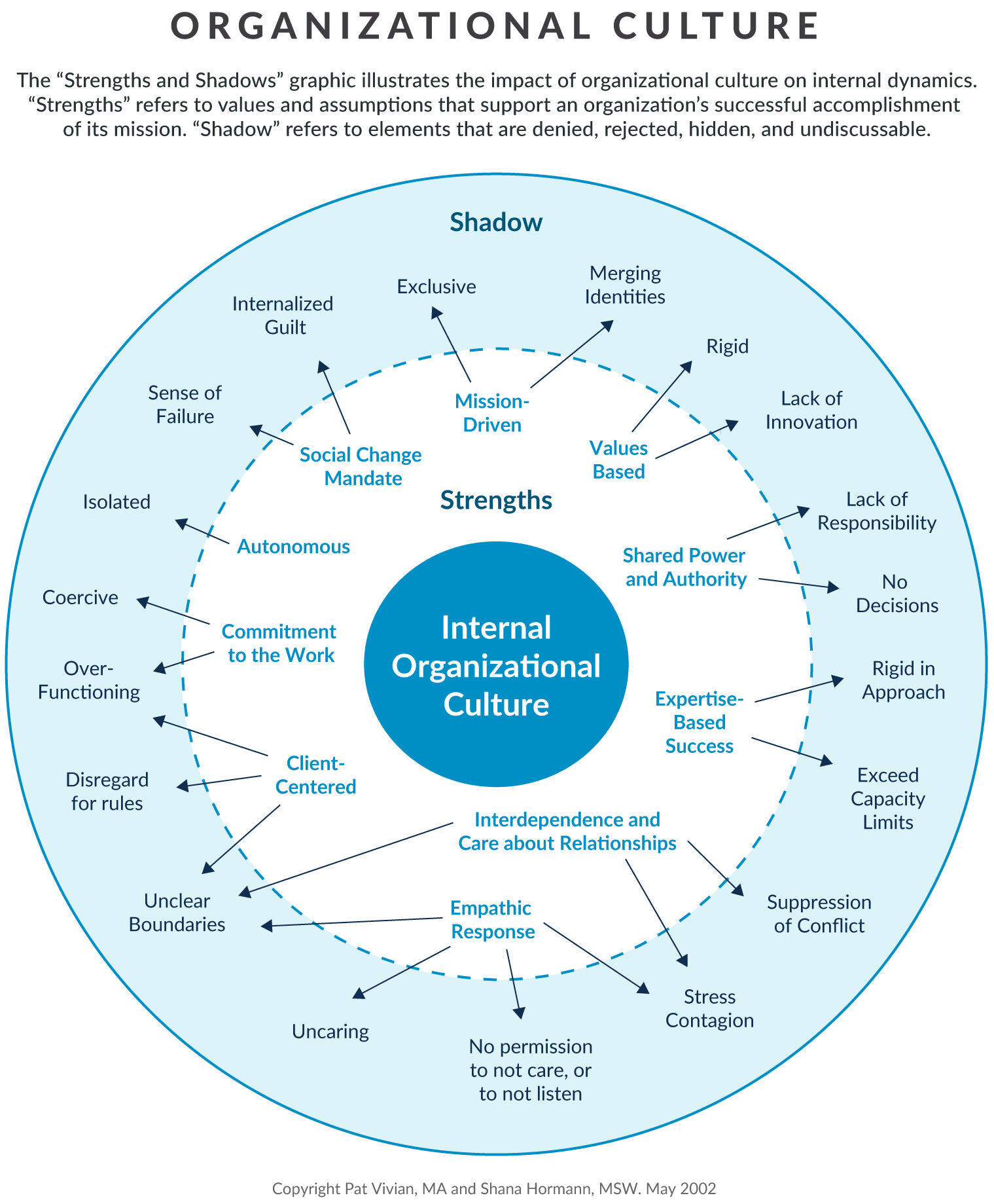
Organizational Culture
In the article, Trauma and Healing in Organizations, the authors explain, “the nature of an organization’s work directly impacts the culture of the organization. An organization that provides services to traumatized individuals, families and/or communities is susceptible to becoming a traumatized system experiencing the cumulative effects of the work itself.” At the agency level, trauma can have significant impacts on the health and culture of an organization. Strengthening of organizational resilience and culture can prevent and mediate this trauma and move an organization from one that is trauma-affected to one that is healing for clients and staff.
Sources of Organizational Trauma
Organizational trauma can be external or internal, caused by a single event or due to the nature of the work. Examples of sources of organizational trauma include:
- Single catastrophic event such as death of a coworker or a natural disaster that disrupts the workplace.
- Ongoing wounding of staff experiencing persistent trauma, which includes external threats to the organization, abusive practices from leadership (e.g., reprisals for sharing information about toxic work culture), or presence of systemic racism.
- Empathic nature of the work without attention to protective factors (e.g., social connectedness and presence of safe and supportive relationships).
- Outdated policies, procedures, and practices that staff view as harmful to clients (e.g., a client intake assessment that includes invasive questions that a case manager views as harmful for the client and is uncomfortable asking).
Symptoms of Organizational Trauma
Organizational trauma can show up in obvious and not so obvious ways. Examples include:
- Organizational amnesia: organizations that are in denial about the existence of trauma in their culture.
- Unrecognized wounding: another form of denial that is particularly common when trauma is caused by racism. Even when trauma is acknowledged, the impact it has on staff is denied.
- Stress contagion: in the absence of safe opportunities for connection, staff may unintentionally spread stress and fear, distrust leadership or feel that something bad is going to happen.
- Unproductive relationships between organizations and environment: unaddressed organizational trauma may eventually impact relationships inside and outside of the organization, this may look like skepticism, suspicions, or sarcasm.
- Depression, despair, and loss of hope: symptoms that include rapid turnover of staff and/or board members, absenteeism, missed deadlines, decreased loyalty and commitment among staff, and other organizational dysfunction.
Organizational Trauma Reflection Questions
Organizational Trauma: Utilize the following reflection questions to think about your experience within your agency and how it may impact you, the work you do, and the individuals you engage with.
- Is there transparency about how decisions are made and why they are made within your agency?
- Are those most impacted by decisions a part of conversations prior to decisions being made?
- Is the majority of staff who are entry level or lower in the organizational hierarchy also members of the populations the organization serves? If so, how is that addressed?
- Who is required to clock in and out as opposed to filling out a timesheet where they auto-populate their arrival and departure?
- Who is able to propose new policies and procedures?
- Who is directly impacted by those policies and procedures?
Resilient organizations are built and nurtured through organizational respect, a strong sense of organizational identity, intentional setting of structures, processes and spaces for reflection, optimistic leadership, and positive connections both internally and externally. Organizations should strive to do the following to strengthen resilience:
- Recognize and acknowledge the existence of organizational trauma. Although leaders may be fearful of opening a “pandora’s box,” providing space for facilitated sharing and transparency about trauma and toxic culture can identify organizational stressors and allow for stories of program strengths to be shared.
- Contain anxiety. By providing trusted and safe spaces for information about ways to cope with anxiety and vicarious trauma, employees feel validated and supported in their experiences.
- Act as an example. Model kindness and compassion with staff and partner agencies.
- Remember history and interrupt amnesia. Normalize the ability and acceptability to elevate mistakes and learnings from the past.
- Strengthen organizational identity and respect. Help staff feel connected to the mission of the agency. Offer optimism, ritualized celebrations, and positive affirmations for successes, big and small.
